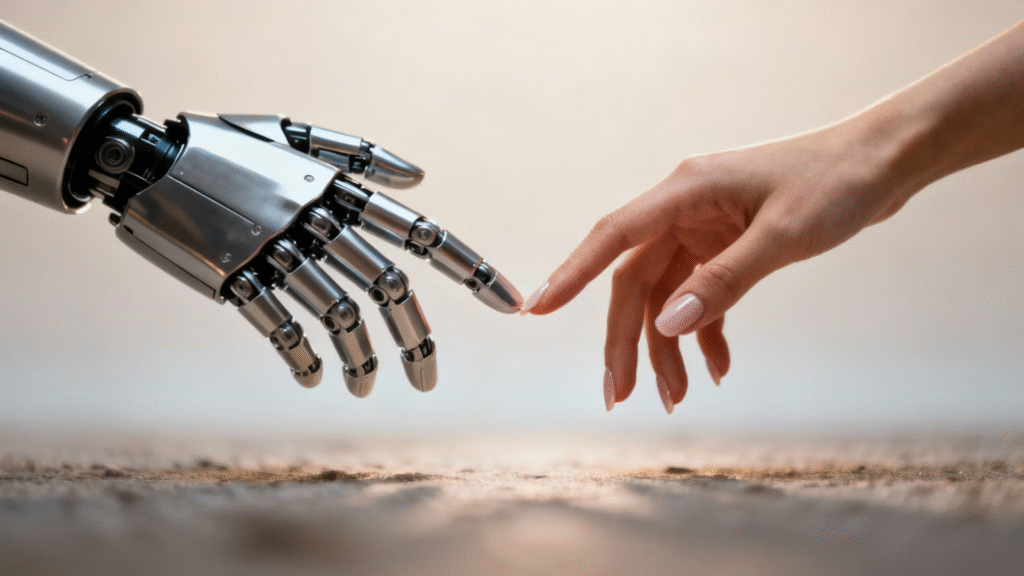The workplace productivity revolution isn’t coming—it’s here. AI-powered productivity tools are fundamentally changing how we work, moving beyond simple time-saving to actual capacity creation.
Unlike traditional tools that merely streamlined processes, artificial intelligence actively multiplies human potential. It amplifies natural strengths, eliminates repetitive tasks, and enhances decision-making quality—effectively expanding organizational talent without hiring additional people.
The Numbers Tell the Story

Recent research from MIT, McKinsey, and Stanford reveals that employees using generative AI demonstrate 33-40% higher productivity per hour compared to colleagues who don’t leverage these tools.
Key Performance Indicators:
- 77% of executives report measurable productivity gains following AI adoption
- 43% of employees now incorporate generative AI into daily routines
- 4.8x improvement in task efficiency with AI-powered workflow tools
- 49% reduction in errors across AI-enhanced processes
These aren’t marginal improvements—they represent a fundamental shift in workplace capability and output quality.
From Efficiency to Amplification: The New Productivity Paradigm
Three Levels of AI Impact
- Automation Level: Machines handle routine tasks like meeting summaries, report drafting, and data organization, freeing cognitive resources for strategic thinking.
- Augmentation Level: AI assists with complex activities—writing, design, analysis, and problem-solving—improving both speed and quality of output.
- Acceleration Level: Teams leverage predictive analytics for decisions that previously required hours of collaborative discussion and research.
The result isn’t just increased output—it’s optimized use of human cognitive bandwidth.
Real-World Performance Gains
- Call Center Transformation: Studies show generative AI boosting call center productivity by 14%, with the largest improvements among newer employees.
- Information Work Revolution: Analysis found 66% throughput increases in information-based roles, with coders completing 126% more projects weekly.
- Consulting Excellence: Trials with 700 consultants showed 40% better performance when using GPT-4 for ideation and structured proposal generation.
The Experience Equalizer Effect

Perhaps the most significant finding: AI disproportionately helps less experienced employees. Research from the St. Louis Federal Reserve demonstrates that AI provides newer workers with tacit knowledge and guidance typically gained only through years of practice.
Closing the Skills Gap
- Traditional Learning Curve: New employees required months or years to reach peak productivity
- AI-Enhanced Onboarding: Junior team members access expert-level insights and decision-making support immediately
- Organizational Impact: Teams achieve consistent high performance across all experience levels
This democratization of expertise transforms team dynamics and accelerates overall organizational capability development.
Beyond Task Completion: Wellness and Sustainable Performance
AI productivity tools extend beyond work output to support employee wellbeing and sustainable performance levels.
Holistic Performance Enhancement
- Adaptive Workspace Systems: AI monitors workflow patterns, stress indicators, and environmental factors to optimize working conditions in real-time.
- Burnout Prevention: Oxford and Deloitte research shows adaptive AI systems reducing burnout rates by 21% and cognitive fatigue by 17%.
- Focus Optimization: Intelligent scheduling and workload management help employees maintain peak performance periods while ensuring adequate recovery time.
- Case Example: Deloitte’s Amsterdam headquarters uses 28,000 environmental sensors with AI analysis to dynamically adjust lighting, temperature, and acoustics based on employee comfort and productivity indicators.
Industry-Specific Transformation Examples
Healthcare Efficiency Revolution
Ochsner Health Implementation:
- 60-75 hours monthly reduction in administrative work through AI scheduling
- 27% improvement in employee engagement scores
- Reallocation of time from coordination tasks to direct patient care
Software Development Acceleration
GitHub Copilot Impact:
- 126% faster task completion rates
- Shift from syntax debugging to architectural innovation
- Enhanced focus on creative problem-solving over routine coding
Professional Services Enhancement
Consulting Productivity Gains:
- 40% better performance in creative ideation tasks
- Improved proposal quality and client presentation effectiveness
- Faster turnaround on complex analytical projects
The Empowerment Model: Amplification Over Replacement
Contrary to early concerns about job displacement, research consistently shows AI amplifying rather than replacing human workers. MIT and Dallas Federal Reserve studies confirm productivity gains exceeding 40% when organizations focus on people-first adoption strategies.
What AI Actually Replaces
- Not Human Thinking: AI doesn’t replace cognitive abilities or creative problem-solving
- Eliminates Waste: Removes time lost to poorly structured reports, inefficient communication, and repetitive research tasks
- Reduces Friction: Streamlines workflows and removes administrative bottlenecks
- ROI Reality: Organizations report productivity returns between 30-200% within the first year of strategic AI deployment.
Cultural Shifts for AI-Powered Success

Three Essential Mindset Changes
- From Tools to Teammates: Treat AI as cognitive collaborator rather than simple software application
- From Data to Decisions: Use AI not just for insight collection but for translating analysis into actionable strategies
- From Control to Creativity: Empower teams to experiment with AI workflows, building adaptive intelligence through hands-on experience
Implementation Best Practices
- Training Investment: Focus on people-first adoption with comprehensive skill development programs
- Experimentation Culture: Encourage creative AI workflow exploration without fear of failure
- Continuous Learning: Establish feedback loops for ongoing AI integration improvement
Building AI-Enhanced Team Capabilities
Successful AI productivity implementation requires collaborative platforms that support the complete workflow enhancement process—from initial tool introduction through advanced capability development.
Collaborative AI Integration
Cross-functional benefits enhance organizational productivity:
- Marketing teams accelerate content creation and campaign development
- Sales professionals improve prospect research and proposal quality
- Development teams focus on architecture over routine coding tasks
- Administrative staff eliminate repetitive data entry and scheduling conflicts
Technology Platform Requirements
Modern productivity enhancement demands integrated environments supporting multiple AI capabilities within unified workflows. Teams need platforms that enable experimentation, collaboration, and skill development simultaneously.
Qolaba‘s AI Studio exemplifies this comprehensive approach by providing teams with access to 60+ AI models through collaborative workspaces. Organizations can implement AI productivity tools across departments while maintaining consistent quality and strategic alignment.
The credit-based pricing model removes barriers to productivity experimentation, encouraging teams to explore AI capabilities without per-user limitations or subscription constraints that might limit organizational adoption.
Key Capabilities:
- Generate process guides, reports, and insights in minutes
- Collaborative editing with context-aware AI suggestions
- Integration of AI assistance directly into daily workflows
- Performance analytics for continuous productivity optimization
The Future of Human-AI Collaboration

The AI productivity revolution represents more than technological advancement—it’s a fundamental redefinition of human potential in professional environments.
The most successful organizations will be those that don’t automate employees out of relevance but amplify human intelligence through strategic AI partnership. This approach transforms every team member into a strategist, innovator, and creator by eliminating the distinction between task execution and strategic leadership.
Competitive Advantage Through AI Integration
Immediate Benefits:
- Dramatic productivity increases without additional hiring
- Improved work quality and reduced error rates
- Enhanced employee satisfaction through meaningful work focus
- Faster decision-making and project completion cycles
Long-term Strategic Value:
- Organizational learning acceleration
- Competitive differentiation through superior execution capability
- Talent retention through enhanced job satisfaction
- Scalable growth without proportional resource increases
Getting Started with AI Productivity Enhancement
Assessment and Planning
- Current State Analysis: Evaluate existing productivity bottlenecks and time-consuming routine tasks
- Goal Setting: Define specific productivity improvement targets and success metrics
- Tool Selection: Choose AI platforms that align with organizational needs and technical capabilities
- Training Strategy: Develop comprehensive adoption programs that address both technical skills and cultural adaptation
Implementation Roadmap
- Phase 1: Pilot programs with early adopters and high-impact use cases
- Phase 2: Gradual rollout across departments with continuous feedback integration
- Phase 3: Advanced capability development and workflow optimization
- Phase 4: Cultural integration and sustained productivity enhancement
Ready to multiply your team’s productivity potential? The AI revolution offers unprecedented opportunities for organizations willing to embrace human-AI collaboration as a strategic advantage.
The future belongs to teams that can effectively combine artificial intelligence capabilities with human creativity, judgment, and strategic thinking—creating workplace environments where technology amplifies human potential rather than replacing it.





